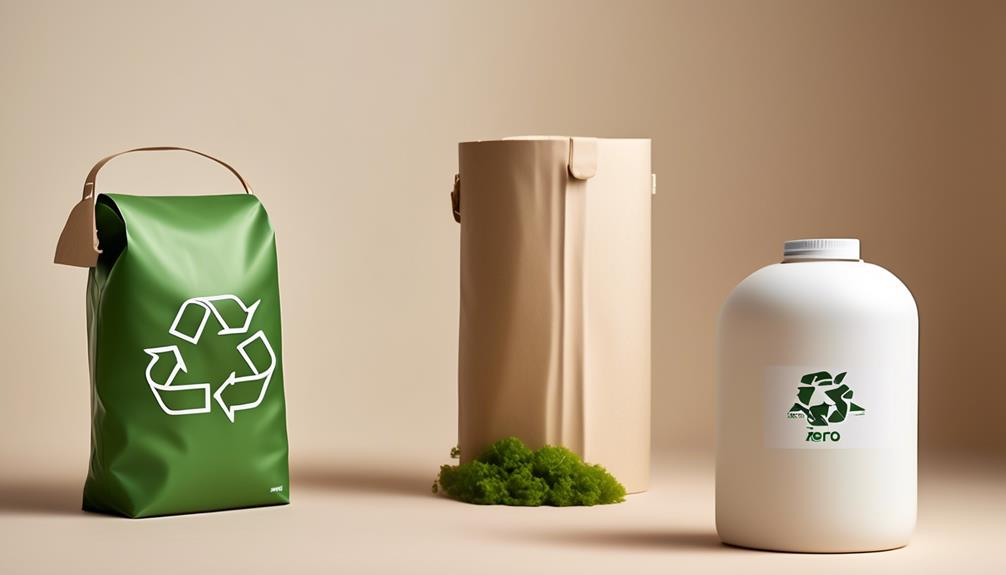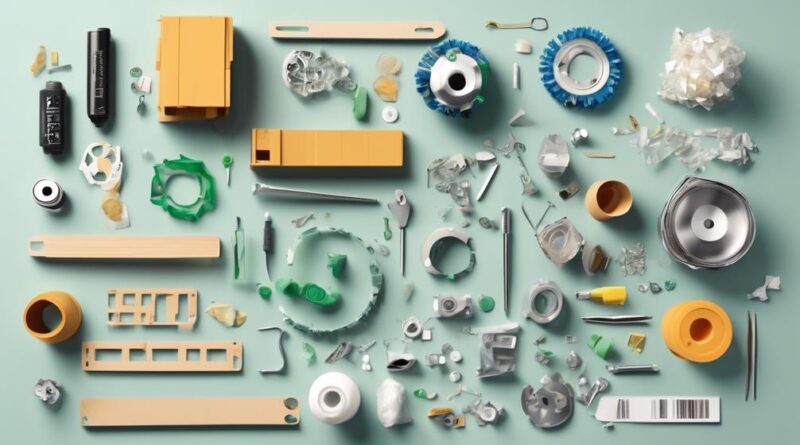Why Is Ecodesign Essential for Achieving Zero Waste?
Imagine ecodesign as the compass that guides a ship through treacherous waters, steering it away from the rocks of waste and towards the open sea of sustainability.
Ecodesign is the crucial tool for achieving zero waste, as it not only minimizes resource use and material waste but also extends product lifespan and reduces energy consumption.
But why is ecodesign so essential for achieving this ambitious goal?
The answer lies in its ability to revolutionize the way we design, produce, and consume goods, ultimately paving the way for a more sustainable future.
Minimizing Resource Use
To minimize resource use, focus on optimizing production processes and reducing material waste through efficient design and manufacturing techniques. By maximizing efficiency in production, you can significantly decrease the amount of resources required to manufacture products. One way to achieve this is by implementing lean manufacturing principles, which emphasize streamlining production processes to eliminate waste and improve overall efficiency. This involves identifying and eliminating non-value-added activities, reducing excess inventory, and optimizing equipment utilization.
Another crucial aspect of minimizing resource use is through the implementation of eco-design principles. By optimizing production through eco-design, you can reduce the amount of raw materials and energy required in the manufacturing process. This entails designing products with a focus on sustainability, durability, and recyclability, ultimately minimizing material waste and resource consumption. Additionally, incorporating innovative technologies such as 3D printing can lead to more efficient use of materials and reduced waste during production.
Furthermore, optimizing production also involves considering the entire product lifecycle, from design and manufacturing to end-of-life disposal. By implementing strategies such as designing for disassembly and recycling, you can minimize waste generation and maximize resource recovery. This approach ensures that materials remain in use for as long as possible, contributing to a more sustainable and resource-efficient production process.
Extending Product Lifespan
Extending the lifespan of products is essential for maximizing resource efficiency and minimizing waste throughout the entire lifecycle. By focusing on repair and refurbishment, products can be kept in use for longer periods, reducing the need for new production and the associated resource consumption.
Long term durability ensures that products remain functional and aesthetically pleasing, further extending their useful life. Here's why these strategies are crucial for achieving zero waste:
- Repair and refurbishment:
- Emphasizing repair and refurbishment as part of ecodesign ensures that products can be restored to their original functionality, reducing the need for replacements.
- Encouraging consumers to repair and refurbish products through accessible resources and services can significantly extend the lifespan of items, minimizing waste.
- Long term durability:
- Designing products with long term durability in mind ensures that they can withstand wear and tear, maintaining their functionality and aesthetic appeal over an extended period.
- Investing in high-quality materials and construction techniques can enhance the longevity of products, contributing to a more sustainable consumption model.
Consider how incorporating repair and refurbishment into product design, along with prioritizing long term durability, can substantially reduce waste generation and resource depletion. These strategies not only align with the principles of ecodesign but also play a pivotal role in transitioning towards a zero waste society.
Reducing Energy Consumption
By implementing energy-efficient technologies, you can significantly reduce the consumption of resources and minimize environmental impact. Energy efficient design plays a crucial role in achieving zero waste by lowering energy consumption during the production, use, and disposal of products. Utilizing energy efficient design principles such as optimizing insulation, using energy-efficient lighting, and incorporating smart technology can lead to substantial reductions in energy usage. This not only decreases operational costs but also lessens the environmental footprint associated with energy production.
In addition to energy efficient design, integrating renewable energy sources into your operations is another key strategy for reducing energy consumption. By harnessing renewable energy from sources such as solar, wind, and hydroelectric power, you can significantly decrease reliance on non-renewable energy sources like fossil fuels. This shift not only contributes to a more sustainable energy mix but also helps in mitigating greenhouse gas emissions and environmental pollution. Furthermore, investing in renewable energy sources can lead to long-term cost savings and provide a more stable energy supply.
Minimizing Material Waste
Consider reevaluating your production processes to minimize material waste and enhance resource efficiency. Design efficiency and waste reduction are essential components of achieving zero waste.
By implementing the following strategies, you can significantly minimize material waste in your production processes:
- Material Efficiency
- Utilize advanced design techniques such as modular design, standardization, and lightweight materials to optimize material usage.
- Integrate 3D printing and additive manufacturing technologies to produce components with minimal material waste.
- Waste Management
- Implement a closed-loop system where production waste is recycled and reused within the manufacturing process.
- Utilize lean manufacturing principles to streamline production processes and minimize excess inventory, thereby reducing material waste.
Enhancing Recycling Potential
To enhance the recycling potential in your production processes, assess the feasibility of incorporating recycled materials into your product design and manufacturing. By using recycled materials, you can reduce the demand for virgin resources and minimize the environmental impact of your products. Additionally, incorporating waste reduction techniques into your manufacturing processes can further enhance the recyclability of your products. Implementing strategies such as design for disassembly and material separation can make it easier to recycle your products at the end of their life cycle.
Furthermore, consider utilizing eco-friendly packaging for your products. Eco-friendly packaging materials, such as biodegradable or compostable options, can contribute to reducing the overall environmental footprint of your products and facilitate the recycling process. Additionally, using packaging made from recycled materials can help close the loop on the recycling chain and reduce the amount of waste sent to landfills.
Incorporating these practices not only enhances the recyclability of your products but also aligns with consumer preferences for sustainable and environmentally friendly goods. By taking these steps, you can't only contribute to a circular economy but also differentiate your brand as one that's committed to environmental stewardship.
Ultimately, enhancing the recycling potential in your production processes is a key aspect of achieving zero waste and promoting a more sustainable future.
Lowering Environmental Impact
Assess the environmental impact of your current production processes to identify opportunities for reduction and improvement. Sustainable manufacturing is crucial for lowering the environmental impact of your operations.
By evaluating the energy and resource consumption, waste generation, and emissions associated with your production processes, you can pinpoint areas for improvement. Here are some steps to guide you in this process:
- Energy Efficiency
- Implement energy-efficient technologies and processes to reduce your overall energy consumption.
- Consider utilizing renewable energy sources such as solar or wind power to further decrease your environmental footprint.
- Waste Minimization
- Adopt lean manufacturing principles to minimize waste generation and maximize resource utilization.
- Explore opportunities for reusing or recycling materials within your production cycle to promote environmental stewardship.
Promoting Sustainable Consumption

To continue advancing sustainability within your production processes, a focus on promoting sustainable consumption among consumers becomes paramount. Understanding consumer behavior is crucial in promoting sustainable consumption. By comprehending the factors that drive consumer choices, you can tailor your marketing and product development strategies to encourage eco-friendly behaviors. Environmental education also plays a pivotal role in promoting sustainable consumption. By raising awareness about the environmental impact of consumption habits, you can empower consumers to make more informed choices. This can be achieved through informative labeling, educational campaigns, and partnerships with environmental organizations to provide resources for consumers to learn about sustainable practices.
Encouraging sustainable consumption also involves making eco-friendly options more accessible and appealing to consumers. This can be accomplished through various means such as offering incentives for recycling, providing easily accessible recycling facilities, and ensuring that eco-friendly products are competitively priced and readily available. Additionally, highlighting the long-term benefits of sustainable consumption, such as cost savings and positive environmental impact, can further motivate consumers to make eco-conscious choices.
Fostering Circular Economy
Fostering a circular economy requires rethinking traditional linear production models and embracing a system that prioritizes resource efficiency and waste reduction. This shift involves designing products and systems that minimize environmental impact and maximize the value of resources.
By adopting ecodesign principles, businesses can contribute to the creation of a circular economy, where resources are kept in use for as long as possible, extracting their maximum value, and then recovering and regenerating products and materials at the end of their service life.
Benefits of Design Innovation:
- Encourages the development of products that are durable, repairable, and upgradable, reducing the frequency of disposal and contributing to resource conservation.
- Promotes the use of sustainable materials and production processes, thereby minimizing the environmental footprint of products and systems.
Contributions to Economic Growth:
- Stimulates innovation and the creation of new markets for remanufacturing, recycling, and refurbishing, thereby generating economic opportunities and employment.
- Reduces the dependence on finite resources and mitigates the risks associated with their scarcity, fostering a more resilient and sustainable economy.
Frequently Asked Questions
How Does Ecodesign Impact the Social and Economic Aspects of Zero Waste Initiatives?
Ecodesign positively impacts zero waste initiatives by considering social impact and economic benefits. It encourages sustainable production and consumption, leading to reduced waste and resource conservation. This approach fosters community involvement and creates opportunities for green jobs.
What Role Does Ecodesign Play in Reducing the Environmental Impact of Packaging Materials?
To reduce waste, ecodesign plays a crucial role in choosing sustainable materials and minimizing the environmental impact of packaging. By incorporating eco-friendly materials and efficient design, you can significantly decrease the environmental footprint of packaging materials.
How Can Ecodesign Principles Be Integrated Into the Design of Electronic Products and Appliances?
To integrate ecodesign principles into the design of electronic products and appliances, consider redesigning materials for sustainable production, incorporating technology for energy efficiency. This approach fosters eco-friendly practices and aligns with sustainable development goals.
What Are Some Examples of Successful Ecodesign Strategies in the Fashion and Textile Industry?
When thinking about successful ecodesign strategies in the fashion and textile industry, consider using eco-friendly materials and sustainable production processes. These can include organic cotton, recycled polyester, and innovative water-saving dyeing techniques.
How Does Ecodesign Contribute to the Reduction of Food Waste in the Supply Chain and at the Consumer Level?
Ecodesign contributes to the reduction of food waste in the supply chain and at the consumer level by optimizing packaging, extending product shelf life, and promoting sustainable consumption habits. This approach minimizes environmental impact and conserves resources.
Conclusion
So, in conclusion, ecodesign is essential for achieving zero waste because it:
- Minimizes resource use
- Extends product lifespan
- Reduces energy consumption
- Minimizes material waste
- Enhances recycling potential
- Lowers environmental impact
- Promotes sustainable consumption
- Fosters a circular economy.
Embracing ecodesign principles can help us move towards a more sustainable and environmentally friendly approach to product development and consumption. This, in turn, contributes to the goal of zero waste.
